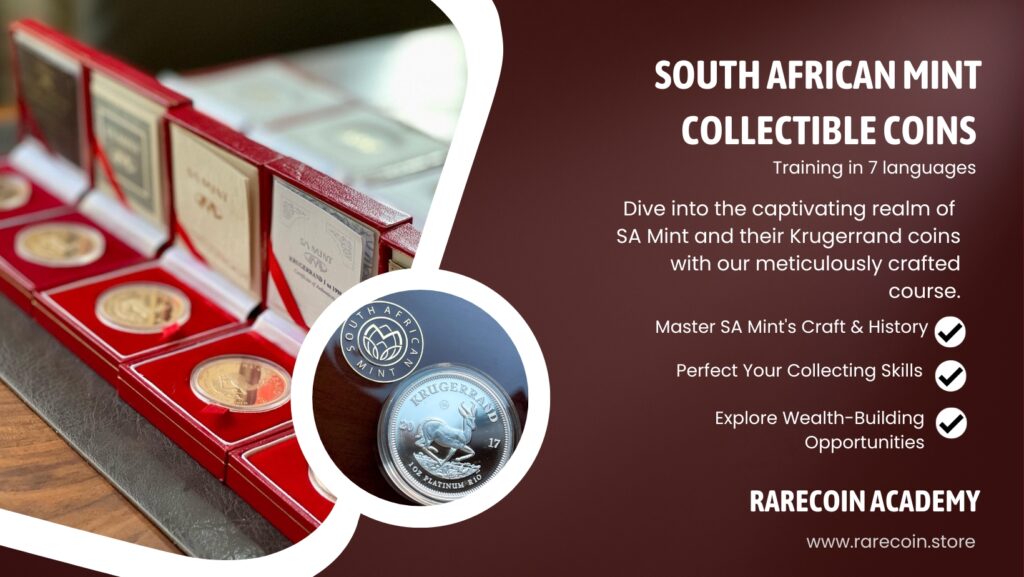
1.2 Origins: The revolutionary first issue of Krugerrand coins
Welcome to our exciting online course, which will take you with passion and expertise into the fascinating world of collector coins from the South African Mint (SA Mint). Whether you are an experienced numismatist or are just diving into the exhilarating universe of coin collecting, in this course you will develop a deep understanding of the cultural and historical significance of the South African Mint’s coins. You will also receive valuable insider tips on how best to evaluate, acquire and care for the exquisite treasures.
The South African Mint – A historic legacy of quality and craftsmanship
Since its founding in 1890 in Pretoria (1890 (First National Mint), 1923 (as a branch of the Royal Mint), 1941 (as an independent Mint)), the South African Mint has established itself as one of the leading mints in the world. Its history spanning more than a century is evidence of a wealth of coins that enjoy recognition and popularity not only in South Africa but also internationally. It combines traditional craftsmanship with the latest technology to produce coins of the highest quality and artistic precision. This combination of innovation and attention to detail makes SA Mint coins true works of art and valuable collector’s items.
1.2 Origins: The revolutionary first issue of Krugerrand coins
In 1967, the South African Mint minted the first Krugerrand gold coins, ushering in a new era. The name “Krügerrand” is a combination of “Kruger”, the then President of the South African Republic Paul Kruger, and “Rand”, the official currency unit of South Africa.
Paul Kruger – A strong symbol of independence and strength
The Springbok – A proud national symbol that adorns the coin
The medalist Coert Steynberg immortalized the elegant springbok on the reverse of the coin. The springbok is not only a magnificent animal native to South Africa, but also a symbol of the country’s pride and unity.
About Coert Steynberg
Born on January 7, 1905 in Hennops River, Transvaal, and died on July 28, 1982 in Pretoria, Coert Steynberg was a gifted medalist and sculptor from South Africa. His artistic repertoire included working with various materials such as stone, marble, bronze, copper and wood.
The protective packaging and the initial sale
To protect them from scratches and damage, the mint carefully packed the first Krugerrand coins in paper envelopes ( SA-Mint paper bag ). This practice was a common method at the time to safely transport coins to buyers while enhancing their presentation. These days it is extremely rare to find sealed and unopened 1967 Krugerrand gold coins for sale.
A total of 50,000 coins were minted in 1967 , of which 10,000 were proof coins .
In 1968, 30,000 investment coins were minted, of which 8,956 were proof coins and 1,044 one-side frosted coins, a total of 10,000 special edition coins.
In 1969 , 30,000 coins were minted, including 10,000 proof coins .
The Krugerrand coins minted during these three years are highly sought after by collectors due to their rarity on the market.
The price of the Krugerrand in 1967
At that time, the world market price for an ounce of gold was $35.10. With a usual retail markup of around 5%, a Krugerrand would have cost around 74 euros.
The unique composition of the Krugerrand: A harmonious combination of copper and gold
The Krugerrand is made from a carefully crafted copper-gold alloy that has a total weight of 1 troy ounce, with one troy ounce consisting of 22-karat pure gold (.917). This composition not only gives the coin its characteristic reddish tint, but also ensures increased durability and scratch resistance.
The diversity and importance of the Krugerrand over time
Over time, the Mint struck Krugerrand coins in various sizes and denominations to appeal to a wide range of investors and collectors. Today, the Krugerrand stands not only as a popular investment in gold, but also as a symbol of South Africa’s rich history and natural resources.
Conclusion :
Overall, the introduction of the Krugerrand coins marks a significant milestone in the history of the South African Mint and numismatics worldwide. With their unique blend of cultural symbolism, craftsmanship and economic significance, Krugerrand coins embody the heritage and innovation of South African coinage. By embarking on this learning adventure, you will not only develop a deeper understanding of the fascinating world of SA Mint collectible coins, but you will also be able to further ignite your passion for collecting these exquisite treasures. It is therefore a special pleasure for us to warmly welcome you to an exciting adventure into the world of coin collecting!
Additional Resources:
From 1967 to today – Questions and answers about the Krugerrand
Buy Krugerrand – What is the cost of a Krugerrand
How much is a Krugerrand coin worth – the most expensive Krugerrand coins

